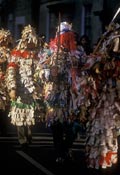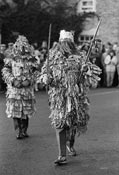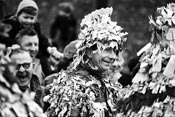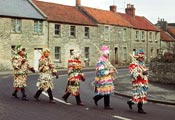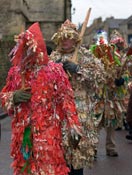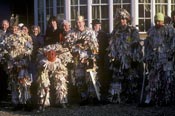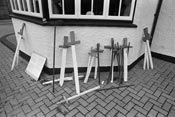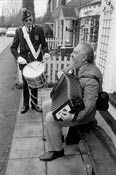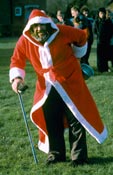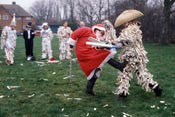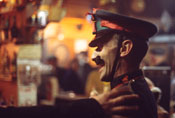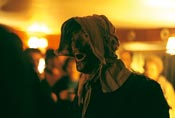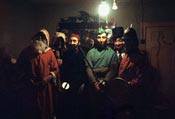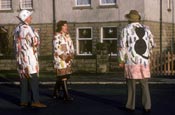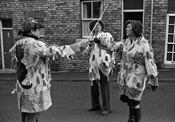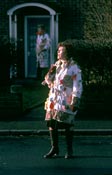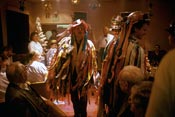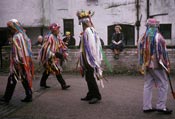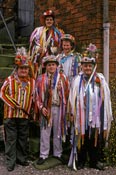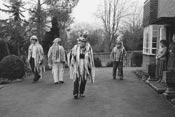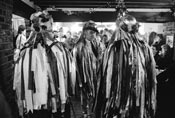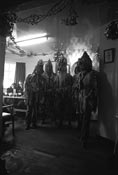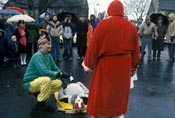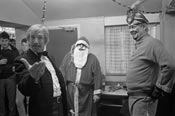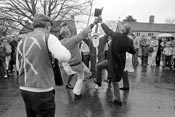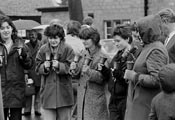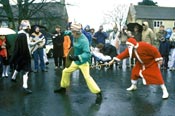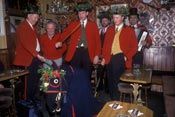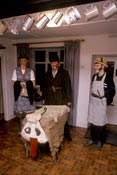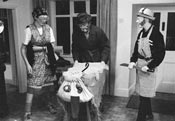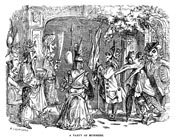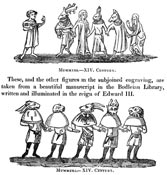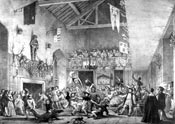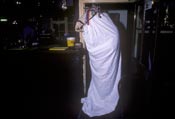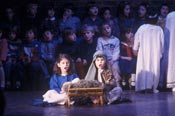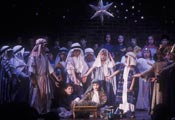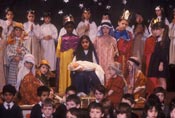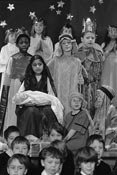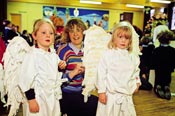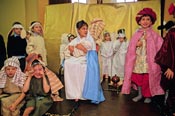
For more detail on Mumming Plays see the section on Plays. Meanwhile here are a few well-known examples – indeed ‘The Celebrated Marshfield Mummers, the Old-time Paper Boys’ are possibly the best known of all. They appear at 11am on Boxing Day, perform several times along the main street and have gone again within a couple of hours. The play has a long history but had relapsed for about 50 years until 1931 when the local vicar happened to hear his gardener reciting part of it as he worked. He mentioned this to his sister, the folklorist Violet Alford, and it was she who persuaded the villagers to resurrect it. Their delivery is straightforward, even formal, perhaps due to the words being put together from a mixture of indistinct memory and academic principle. It has been going ever since and has become one of the great ‘folk’ magnets of the year with many visitors.
Crookham Mummers come out at noon on Boxing Day. Also ‘paper boys’ but in their case wallpaper samples and not newspaper. This is an exuberant affair. They take out many wooden swords and regard it as hallowed tradition to break the lot in combat!
Bampton Mummers tour the ‘big houses’ and then the pubs on Christmas Eve. Here they dress ‘in character’ though their play remains essentially the same.
The Ripon Sword Dancers perform all Boxing Day in pubs, houses and the streets of Ripon. There is no sword dancing involved but at one time this play came in the middle of a longer ritual dance. The sword dancing faded away but the play, and the name, live on. Women are not seen in mumming plays as a rule, certainly not in ‘traditional’ groups, so these pictures are unusual. Margaret Chambers is the daughter and niece of Hardcastles who had been ‘carriers’ of the Ripon Sword Dance for generations. By 1982 the performers had dwindled to three and one of them refused to go out after an argument. Exasperated, Margaret decided to go out herself, a big break with precedent, but it was that or nothing and as it was there were only three of them to play five parts. Ripon was delighted to see her and there were no folklorists present to complain. She and her husband Tom gave up after a few years, but not before they had recruited cousins and friends. The Ripon Sword Dancers were revived.
Uttoxeter Guisers may not be so lucky. This extraordinary group has not been out lately, and they were so amazing and individual that it is doubtful if a ‘revival’ group could get anywhere near their style. Still, when they did come out it was on Christmas Eve around the town pubs and in the houses on Christmas morning, declaiming their play at full volume without meaningful inflection, striding about incessantly. Fantastic stuff – but not easy to photograph!
Headington Quarry Morris Dancers transform themselves into mummers on Boxing Day and perform their play around the Quarry pubs. The play is fairly standard but the show includes other folkish things such as handbell ringing, rapper sword dancing, morris dancing and a wassail song – at least it did back in the 1980s but we suppose the programme might change according to how the Christmas spirit moves them.
The Derby Tup is a short version of the folk play performed by boys, and sometimes girls, in the area around north Derbyshire and south of Sheffield. Being youngsters, manifestations of the Derby Tup are now rare and unpredictable, but if they do get themselves together it could be any time over the Christmas period.
Mari Lwyd is a figure with a horse’s head, once common in South Wales but now a rarity. This one was at Llangynwyd, near Maesteg, evidently still around. This is not really a play, even if the ‘horse’ and his attendants are related to the Old Horse and characters of the souling plays in Cheshire and elsewhere. In this area it is a visiting custom in which the party arrives at a house where a sort of improvised rhyming contest ensues (in Welsh) between them and the householder. If they don’t win they are not allowed in – in theory at any rate. Bit like a rapping contest.
Nativity Plays are of course quite different. Nevertheless they are plays, and for obvious reasons, they take place just before Christmas. Trouble is that these days they are becoming victim to ridiculous PC strictures about multiculturalism and the religious sensibilities of immigrant pupils and parents – and paranoid education authorities. Furthermore all photographers who point a camera at a child are automatically accused of gross paedophilia. So nativity plays could be on the way out, and if they do survive it will be in secret. Enjoy these pictures while you can. They were taken (with friendly permission) in north London in the 1980s. The children involved would have children of their own by now.
